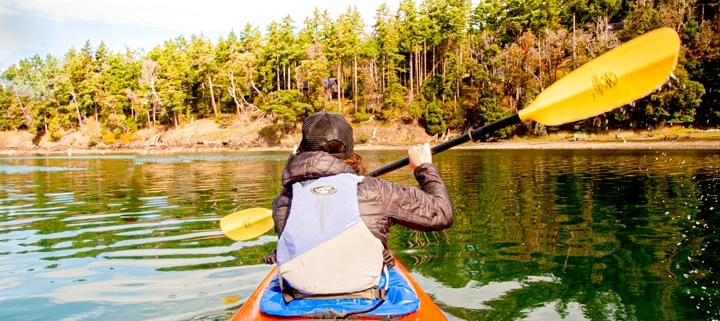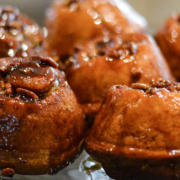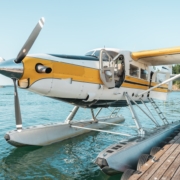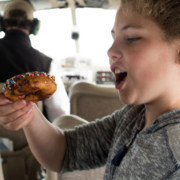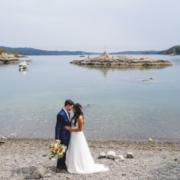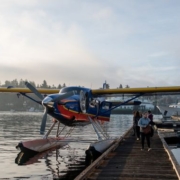From the Water’s Surface: Sea Kayaking in the San Juans
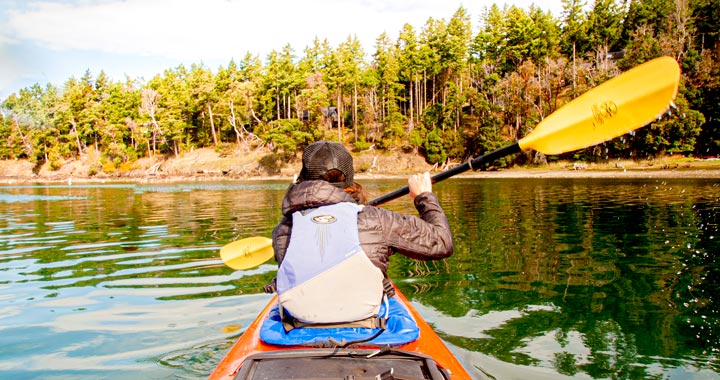
Tucked in the Strait of Juan de Fuca, at the watery edge of the US and Canadian border, the San Juan Islands are a kayaker’s paradise.
The more than 170 islands and inlets are sheltered from the biggest ocean swells. This is thanks to their neighboring landmasses — the Olympic Peninsula and Vancouver Island. And though tucked in the wet Pacific Northwest, this remote archipelago is located at the center of the Olympic Rain Shadow (aka the ‘Banana Belt’). The unique sunshine blanket is created by the Olympic Mountains which condenses and squeezes most of the air’s moisture from the sky before it reaches the San Juans. The result is an average of 270 days with sunshine a year — making this arguably the happiest place in Washington.
As with many remote destinations, the San Juan Islands have attracted a quirky culture of artists and artisans who operate at a slower pace, who savor views a little longer, and who love nature with an unending passion.
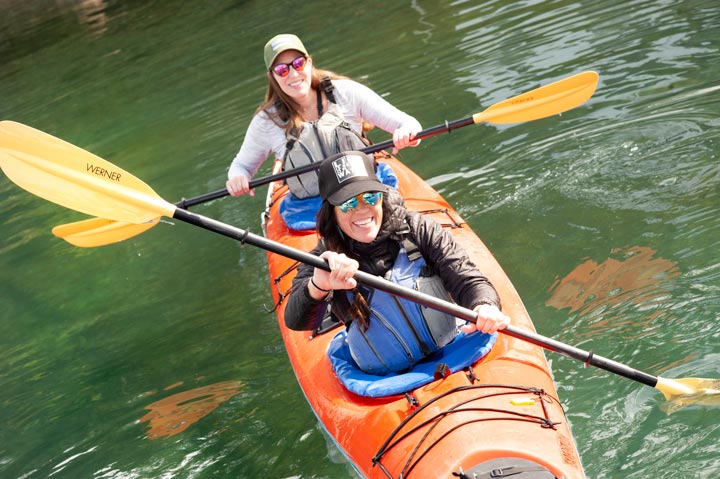
Why wouldn’t the island residents when they’re surrounded by such beauty on a daily basis? Here, second-growth firs tower along the shores; bald eagles swoop overhead; and endangered orcas cruise through their waters.
The beauty in the San Juans is endless and always changing. The sunsets are a riot of pristine color. The air is heady with the crispy scent of salt. There’s no better way to experience it all than floating just inches from the water’s surface.
Sea Kayaking Offers the Best Views
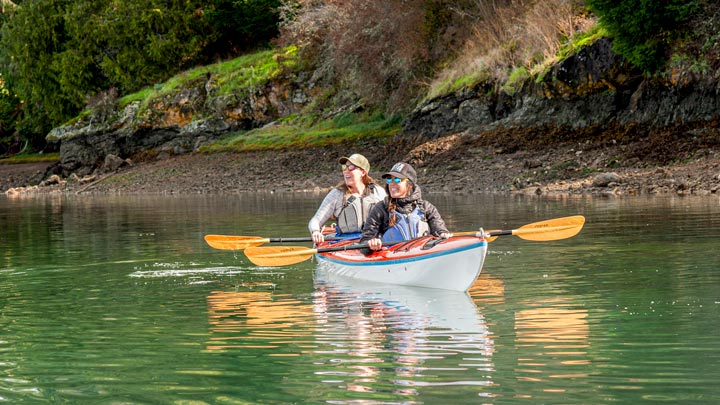
More so than any other vessel, the sea kayak allows you to see the shore and waterways from an angle that would otherwise be inaccessible. With a minimal below-surface profile, the kayak can navigate past rocky shorelines. The wide and sturdy base lets these man-powered crafts cut through waves. And when you’re outfitted with a spray skirt (a flexible, waterproof cover that keeps water from entering the kayak), you don’t have to worry about the chilly waters splashing into your boat.
Exploring the islands by kayak gives you a true sense of their preserved ruggedness, especially considering some of the small outcroppings remain uninhabited. Speckled among the forest-lined shores you’ll find small sandy beaches and spectacular bluffs. Tide pools teem with sea stars. Seals bob between the rocks. And large sea lions sun themselves near the water’s edge.
On clear days you can see Mount Baker rising to the east and the Olympic Mountains to the south. Beneath the water’s surface, lush bull kelp forests wave with the rhythm of the ocean’s currents.
A type of algae, bull kelp can reach up to 200 feet in length and weigh upwards of 300 pounds. These underwater forests play an essential role in the San Juan Islands’ marine food web — providing both shelter and food for many of the region’s small herbivores. Orcas are also known to love swimming through the suspended plants. It’s suspected they enjoy how the beds scratch their back. As the kelp reaches the water’s surface, it creates a floating raft.
This can be a good place to “park” your kayak and take a rest, as the floating beds provide protection from the ocean’s currents and waves. It’s also a good place to spot wildlife. Sea otters and seals can frequently be seen wrapping themselves in kelp while napping.
Gear Essentials
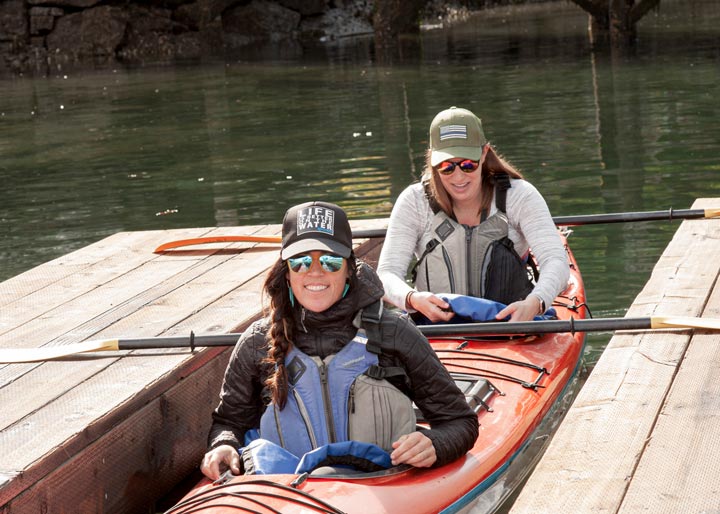
While day-time temps in the San Juan Islands rarely drop below the 50s in the spring, summer, and fall, the average water temperature ranges from 42 to 50 degrees. “That can make for a cold day if you get wet,” explained Crystal Seas Kayaking guide, Clay Seier.
That’s why Clay always recommends bringing a rain jacket. “You often won’t need it. But if it starts to rain, you’ll want to have it,” said Clay. Long sleeves, a baseball cap, and sunblock are also strongly encouraged. Kayakers who want to bring extras like a camera, phone or food also benefit from a dry bag, as it keeps these items from getting wet.
But it’s sunglasses Clay says he can’t live without. “Not having sunglasses is practically a reason not to go. The glare from the water can make for a pretty unenjoyable day,” he said.
Kayaking is Great for Everyone
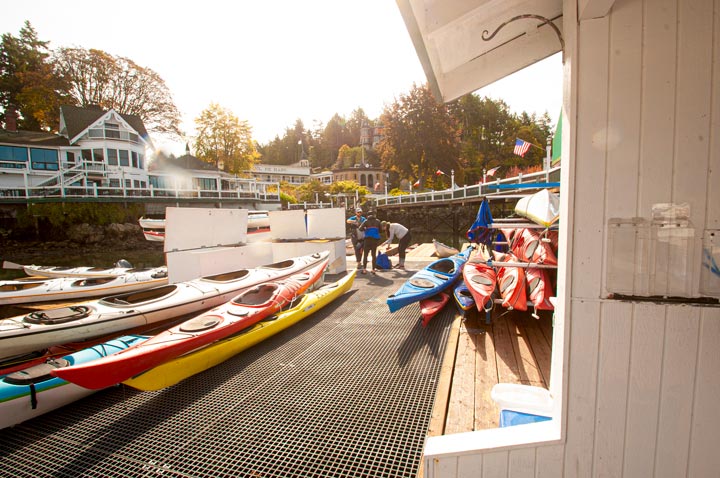
A sea kayak guide for six years, Clay knows his way around the water. “One of the things I love about sea kayaking is that it’s good for everyone. It’s not restricted by age or athletic ability,” said Clay.
He emphasized that kayak tours can always be taken as slowly as the group needs to go. “The beauty of traveling at a leisurely pace is that you get to see things you would often miss. During the summer I’m out here almost every day and I still see things that surprise and excite me.”
Kayak tours in the San Juans range from an hour to multi-day adventures. For a day-tripper, three-hour tours, like the ones offered by Crystal Seas Kayaking, are ideal. They treat you a hearty taste of the region while giving you the flexibility to get back home the same day.
Will You See Whales?
You might. But because kayaks move at a much slower pace, seeing whales while sea kayaking is much less common than aboard a motored vessel. If seeing whales is your top priority, consider a multi-day kayak tour to increase your chances or a dedicated whale watching tour, like those offered by San Juan Safaris.
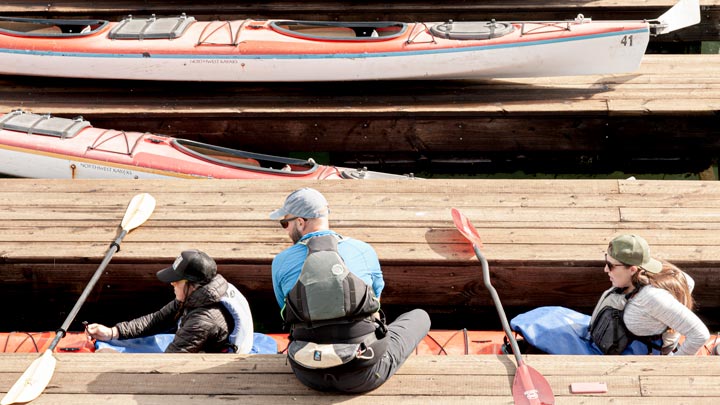
Sea Kayaking Tip: Use Your Core
Always engage your core while paddling to avoid tiring easily. A good way to encourage yourself to do so is with the mantra, ‘In at your feet. Out at your seat.’ You want to reach forward with your whole upper body and pull back with your abs engaged to reduce the stress placed on your shoulders and arms.
Best Time to Visit: Summer
May through September is considered the ideal sea kayaking season in the San Juan Islands because the weather is more predictable and the wildlife more plentiful during the summer. That being said, wildflower enthusiasts will love that the wind-swept prairies along the coast are studded with blooms during the spring.
What to Bring: Water
Drinking ocean water is strongly discouraged. So, it’s always a good idea to bring a bottle of water with you to stay hydrated while out and about. Depending on the length of your trip, you might also want to have a small, easy-to-eat snack.

